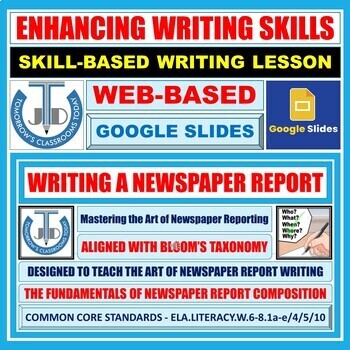Mastering the Art of Newspaper Reporting - Google Slides
- Google Slides™
- Internet Activities

Also included in
- "Mastering the Art of Newspaper Reporting" is a comprehensive resource designed to help students of all levels grasp the fundamentals of newspaper report composition. From the building blocks to the advanced techniques, this resource provides a structured learning experience for all. This resource pPrice $11.90Original Price $17.00Save $5.10
Description
"Mastering the Art of Newspaper Reporting" is a comprehensive Google Slides designed to help students of all levels grasp the fundamentals of newspaper report composition. From the building blocks to the advanced techniques, this resource provides a structured learning experience for all. This resource provides a holistic learning experience, offering reading and writing rubrics for marking, passages for planning and writing newspaper reports, and opportunities for self-checking answers. By the end of "Mastering the Art of Newspaper Reporting," students will be well-equipped to craft engaging, informative and professional newspaper reports.
This resource includes:
REMEMBERING
- Recall key components of a newspaper report.
- Identify the basic structure of a newspaper report.
- Recall key elements such as headline, deck, byline, date-line, place-line, lead, body and conclusion.
- Remember the importance of a catchy headline for grabbing readers' attention.
- Match the structural elements of a newspaper report with their meaning.
- Match the definitions of key elements with their impact on the readers.
UNDERSTANDING
- Demonstrate an understanding of the purpose and audience of newspaper reports.
- Explain why newspaper reports are written and their role in journalism.
- Identify the target audience for different types of newspaper reports.
- Demonstrate comprehension of the tone and style appropriate for a newspaper report.
- Understand the author’s use of language in a newspaper report to answer the questions that follow.
- Select the best option that answers the question.
APPLYING
- Apply their understanding of newspaper report writing conventions to create their own reports.
- Craft a well-structured newspaper report using the appropriate format.
- Apply journalistic writing techniques such as the inverted pyramid style.
- Use quotations effectively to enhance the authenticity of the report.
- Select relevant material from the passage and write a news report, with a suitable headline, for the next day's local newspaper.
- Select relevant material from the passage and plan a newspaper report.
- Use the sample plan to write the first draft of a newspaper report.
- Use the sentence frame to write the final draft of a newspaper report.
ANALYSING
- Analyse the effectiveness of different newspaper reports.
- Critically assess the use of language and tone in published newspaper reports.
- Analyse how various reports present facts, opinions and evidence.
- Compare and contrast different styles of reporting for diverse news stories.
- Analyse the newspaper report and identify the elements and their impact on the reader.
- Answer key to self-check the answers.
EVALUATING
- Evaluate the credibility and reliability of sources used in newspaper reports.
- Assess the reliability of information from various sources.
- Evaluate the credibility of quoted individuals in a newspaper report.
- Formulate opinions on the overall trustworthiness of a news report.
- Evaluate the newspaper report for the author’s use of language.
- Answer keys to self-check the answers.
- Reading and writing rubrics for marking
CREATING
- Create original and engaging newspaper reports.
- Develop a captivating headline that accurately reflects the content of the report.
- Synthesise information from various sources to construct a comprehensive news story.
- Integrate multimedia elements (if applicable) to enhance the visual appeal of the report.
- Differentiated tasks – prompts based on student data and learning levels (below average, average, above average and very high)
- Passages to read, plan and write the newspaper report
More reading and writing resources by the same author:
This is what teachers say about these resources:
- PREPOSITIONS OF PLACE: 27 GOOGLE SLIDES - comment from A Social Teacher: "My students found the slides very engaging." Rating: 5/5 (extremely satisfied)
- SENTENCE KINDS BY FUNCTION: 24 GOOGLE SLIDES - Denise Hickey: "This is a great resource that is easy to use." Rating: 4/5 (very satisfied).
- IDIOMS: GOOGLE SLIDES - BASED ON BLOOM'S TAXONOMY - Marie Seaman: "Super resource!" Rating: 5/5 (extremely satisfied)
- IF- BY RUDYARD KIPLING - READING A DIDACTIC POEM - GOOGLE SLIDES - Comment from Aaron Nicholson: "This resource assisted me in teaching my scholars not just about didactic poetry but enhanced my instruction on how to analyze this particular poem." Rating: 5/5 (extremely satisfied)
Customer Tips: How to get TPT credit to use for future purchases
- Follow me HERE to get notified of updates, sales, free resources, and new products.
- Please go to your My Purchases page (you may need to LOG IN). Beside each purchase, you'll see a Provide Feedback button. Simply click it, and you will be taken to a page where you can give a quick rating and leave a short comment about the product.
- Each time you give feedback, TPT gives you feedback credits that you can use to lower the cost of your future purchases.
- I value your feedback greatly, as it helps me determine which products are most valuable for your classroom so I can create more for you.
- Look for the green star next to my store logo and click it to become a FOLLOWER. You will now receive email updates about this store. Be the first to know about my new discounts, freebies, and product launches.
Find Me Here:
- TPT Store - JOHN DSOUZA
- Pinterest - JOHN DSOUZA
- Facebook - TOMORROW’S CLASSROOM TODAY
- Instagram - JOHN421969
- Twitter - JOHN421969
- Boom Learning - JOHN DSOUZA
- YouTube - JOHN DSOUZA






